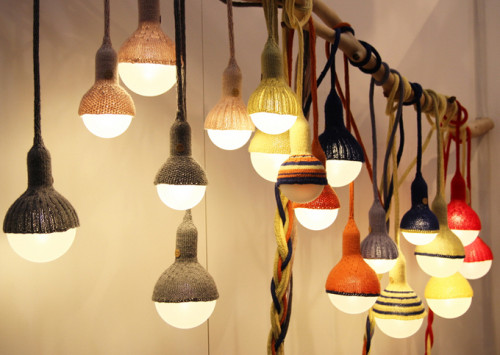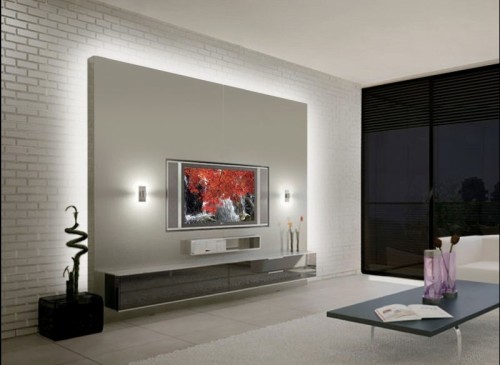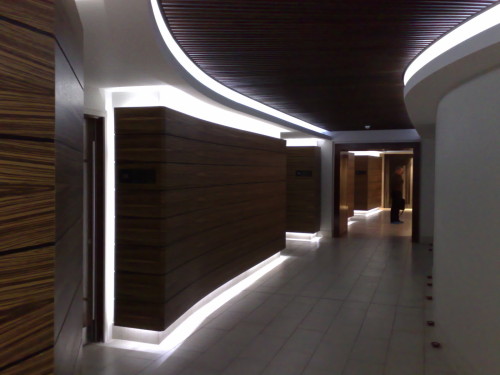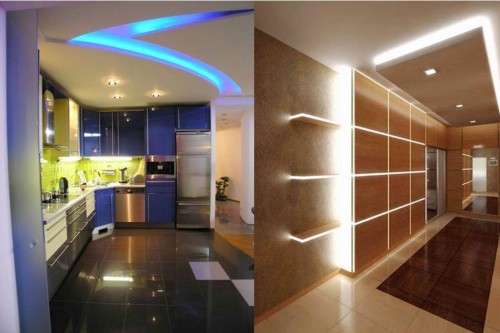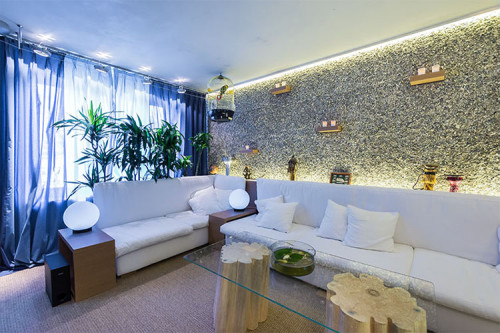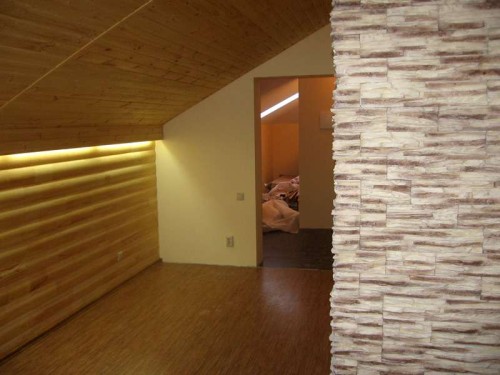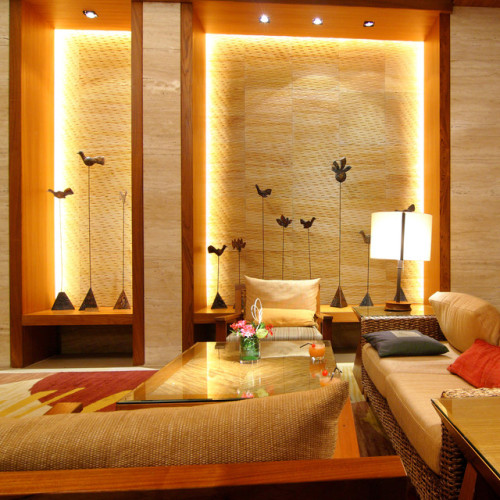Decorative wall illumination today is an original technique that is performed primarily to create an aesthetic effect and add interior. But at the same time, lighting elements that are used for this purpose can be independent light sources. Lighting of a decorative nature allows you to diversify the space of the room, it is profitable to complement the design of the home and give it a complete look. Consider the features of the use and installation of the backlight.
Content
The choice of lighting devices
The lamps with which the walls are illuminated are classified into several types:
- Suspended lamps. In their appearance, they resemble desktop devices. Many models of such products allow you to regulate light, directing it in the right direction.
- Lamps with ceilings. These elements can have a different shape: square, round, rectangular or any other. Mostly they are made of hazardous or white matte glass. The main area of \u200b\u200btheir use is bathrooms and hallways.
- Wall sconces. Their main advantage is high aesthetic indicators. These elements are fixed using special brackets. They differ in a variety of models, which allows you to choose a lamp for any interior.
- LED products. In their operational characteristics, they surpass the lighting elements of other types. LED devices consume less energy, give brighter lighting, are environmentally friendly, have greater strength and serve a longer period.
- Built -in lamps - designed for installation in the wall. These products give multiple light, so it is advisable to install several units. They are divided into several types:
- lED-A03B lighting elements-designed for installation in walls made of concrete or drywall material without the use of a mounting box;
- lED-J04 devices allow you to create the effect of light coming from the inside of the wall due to a certain direction of the light flow. Installation is carried out using specially designed spacers;
- the LED-L02B model gives soft backlight and is mounted using plastic fasteners;
- lED-HH02 lamps are economical and used for night illumination.
LED wall lighting
To create this type of lighting, flexible ribbons with LEDs are used. These lighting elements have an adhesive base, with which their fastening is carried out. Similar tapes are recommended to be installed on a metal profile, which will play the role of heat sink. This will extend the period of operation of LED lighting.
Important! Installation of the tape is possible without the use of thermal conductive material, but in this case the LEDs overheat and fail.
The tape goes on sale by fragments of 5 m in the form of coils. When choosing a tape, criteria should be taken into account as:
- brightness of LED elements;
- their number on one meter;
- type of tape;
- the degree of protection against mechanical exposure.
When decorating large rooms, the tape can be interconnected by soldering or using special connectors. The first method was most widespread, since in this case the material is not oxidized. The functioning of the tape is carried out by means of power supplies, which are connected to the most lighting element and a source of 220 W. Blocks are of different capacities - 12 and 24 watts. When choosing them, you need to take into account the power indicator of the tape and its length.
Management of LED products is carried out by the remote control and controller. With their help, you can change the color of lighting, its brightness, turn on and off the device. However, it is worth taking into account the nuance that when combining several tapes, the controller cannot cope with a large load, then you need to add amplifiers.
LED backlighting walls. Photo:
Features of installation of LED backlight:
- When working with LED strip, the level of the moisture content of the room should be taken into account.
- Open ribbons are used to illuminate the walls from the inside. They go well with decorative plaster, brick and drywall surfaces.
- The external walls are illuminated using hermetic products.
- If it is supposed to perform work in the room where the humidity indicator is increased, closed tapes should be used. These are elements whose LEDs are covered with silicone composition. Due to the presence of such a protective layer, the lamp will function even with direct contact with moisture.
Important! It is not recommended to use these tapes in rooms where humidity is within normal limits, since they have a certain drawback. The light, which passes through the protective silicone coating is more dim. In addition, silicone over time becomes more muddy, which further worsens lighting. For this reason, the use of these fixtures should be justified.
The placement of the tape depends on the desired effect:
- When placing a lighting element into the opening of the wall or a ceiling cornice, the glow is directed from top to bottom.
- The backlight can be located in the lower part. In this case, it is placed in a niche or floor plinth.
- The backlight in the niches of the walls allows you to highlight the objects in it, such as photographs, paintings or various decorative elements. This part of the room can only be used as a decorative element, or can have a practical purpose. In this place quite often placed functional objects, for example, a TV. The backlight niche will look more original and attractive.
Before you make the backlight in the niche in the wall, you need to decide on the location of the lighting elements:
- To get an idea of \u200b\u200bthe final result, it is recommended to draw a schematic pattern.
- Then you should calculate the amount of the tape that will be required to decorate the niche. A variety of colors makes it possible to choose a tape for the interior decorated in any direction. If necessary, it should be cut into several parts.
- Next, the tape is mounted in pre -designated places. A protective film is removed from the wrong side of the lighting element, and it is attached in the appropriate place.
- Then all elements are connected to the power supply, and it, in turn, is connected to the network.
- After the installation is completed, the LED backlight in the niche of the wall is checked for performance.
How to make a wall backlight using a laminate
This type of backlight design is very original and at the same time is low. And simple rules for performing work will make the illumination with your own hands.
To implement this project, the following will be needed:
- wooden strips;
- laminate boards;
- light tubes;
- screwdriver or screwdriver;
- level;
- saw or jigsaw;
- screws;
- mounting glue;
- self -tapping screws;
- scotch.
The installation process is carried out in the following sequence:
- First you need to draw on the wall the location of the light pipes. These elements should be placed so that after completion of the work, only light is noticeable, not communication. For this line, it is better to apply a line on the wall at eye level.
- After that, you need to carry out a cable according to the drawn scheme and fix it using special holders or screws.
- When installing a cable, it is important to correctly determine the length, as it will need to be connected to the power source. In this regard, it is advisable to carry it out of the place where the socket is placed or it is planned to install it.
- Next, you need to install lamps, boards and fix the light mechanism.
- Wooden strips are cut into fragments (in this case, their size can be different) and attached evenly to the surface of the wall.
- Then the boards should be glued to the strips. Work should be started from below and move in the upper direction. A certain pressure will come from the upper boards to the lower elements, so the installation must be carried out as the glue dries. To maintain their position, you can use tape or nails.
- After that, you need to connect the power, and this is where the work is over.
Built -in wall illumination
Among the variety of lighting elements, built -in lamps are highly popular. They illuminate the room well, and at the same time the need for additional wall or suspension devices disappears. Built -in elements can be included at the same time or only one lamp. Such a backlight is built in most cases into the plasterboard walls and implies the performance of such actions:
- Before starting work, it is necessary to determine the zones in the room that need lighting and its intensity. If necessary, illuminate a certain place, the power of the lamps should be calculated so that the light does not turn out to be too bright.
- At the preparatory stage, you should also pay attention to the style design of the room. Lighting should correspond to the interior.
- It is not recommended to install lighting elements only in the central part of the wall. Symmetrically located lamps at an equal distance from each other will look more attractive. Thanks to this location, the lighting will spread evenly throughout the room.
- Next, you need to indicate the places of placement of lamps in the wall. Since plasterboard sheets are mounted on the frame, in the designated areas the material should be pierced to make sure that there are no crossbars. If profiles are found in this way, the fastening zones must be shifted.
- Then it is necessary to measure the lamp in diameter and, using the compass, make appropriate marks on the surface of the wall.
- In the designated place with a knife, a hole is cut.
- Next, you need to extract the power supply and clean its ends. To connect the wire to the lamp, connecting clips are used.
- An electric box is inserted into the hole, and then fixed by means of screws.
- Then a lamp is placed in it, which is fixed using a spring. This greatly facilitates the installation process.
- On this, the wall with drywall backlight is ready.
Recommendations for the process
For the most uniform distribution of the light flow, it is recommended to place lamps at 2 m from the floor. If you install lighting elements under the ceiling, this will achieve bright lighting. If necessary, get a muffled light, they should be located closer to the floor.
There are also certain recommendations regarding the placement of backlight in different rooms:
- For a bedroom, sconces are best suited. They are installed on both sides of the bed or at the head of the head.
- The same lamps are used in the design of the corridors. Placed at the level of human growth, they are a kind of decor for walls.
- Also with their help you can arrange mirrors.
- In the living room, the most suitable zones for illumination will be a place above the sofa or chairs.
- In the bathroom room, you need to light the area near the mirror. For this purpose, sconces or built -in lighting elements are used.
- In the kitchen, the backlight should be placed above the dining table.
With the help of lamps, you can visually adjust the space. If they are installed on only one wall, the room will seem longer. The lighting elements placed in the upper part will direct the light flow down, so that the room is visually increased. The warm color will create the impression of close -up objects, and the cold will visually disturb them.
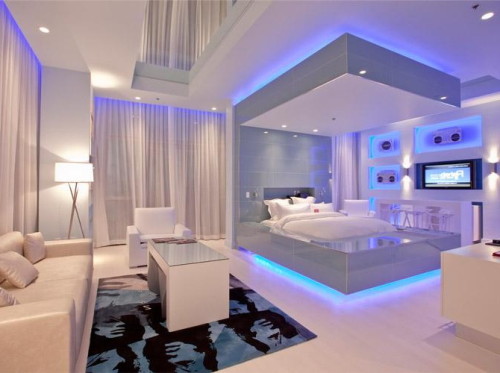
Conclusion
With your own hands, the backlight allows you to transform the interior, to make a note of originality into the decoration of the room. At the same time, correctly selected and installed lighting elements can give intensive light, in which the need for main lighting will disappear. The backlight should not radically differ from the design of the room, but act as its additions. The installation technology of modern lamps is quite simple and is performed in a short time. At the same time, special skills and knowledge are not required, and a non -professionals will successfully cope with work.
How to make LED backlight shown on the video:

